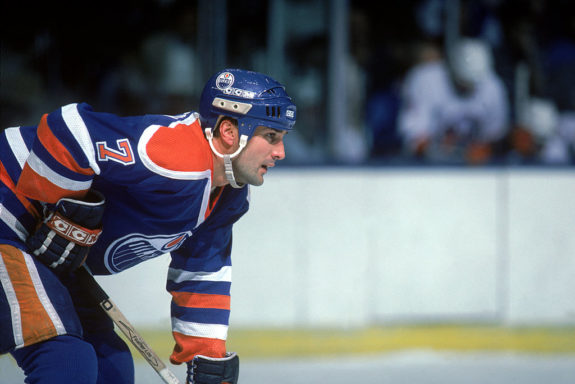In scoring his 14th goal of the 2021-22 season with a dazzling move against the Chicago Blackhawks, blueliner Cale Makar of the Colorado Avalanche extended his lead in goals by a defenseman this season. More than that, the overtime winner inches Makar closer to challenging the single-season record for goals by a defenseman (48), set by Paul Coffey of the Edmonton Oilers in 1985-86.
There remains over half of the season left to play, plenty of time for Makar’s shooting luck to regress and to fall off of Coffey’s record pace. Still, what if he doesn’t? Dig in for a look at whether Makar can supplant the Hall-of-Fame defenseman, currently atop the all-time leaderboard, and write his name in the history books in the process.
Coffey, Orr, and Potvin Dominate Single-Season Scoring Leaderboard
Coffey owns eight of the top 20 most prolific goal-scoring seasons by a defenseman and three of the top five. Bobby Orr (4) and Denis Potvin (3) are his only comparables in this regard, although neither enjoyed the benefits of sharing the ice with Wayne Gretzky or Mario Lemieux for the majority of their careers.
Doug Wilson (39 goals), Kevin Hatcher (34), Mike Green, Phil Housley, and Ray Bourque (all three with 31) are the five other defensemen to score 30 or more times in a single season. It’s an exclusive club with fewer than 10 total members over the NHL’s 104-year history, and cracking it is a remarkable feat in its own right.

In scouring the 20 highest scoring seasons, it becomes apparent that frequent power-play deployment is necessary to crack the all-time leaderboard. Of those 20 instances, 15 were boosted by 10 or more goals with the man-advantage, capitalizing on the offensive freedom afforded by the power play. Interestingly, Coffey’s record-setting season only saw him score nine power-play goals, the fewest of the top five. With three power-play tallies in 26 games, Makar is on pace to finish the year with nine, coincidentally matching Coffey’s output. Could that be a good omen for the blossoming superstar, especially considering his relative aversion to power-play goals?
Coffey’s Record Untouched in 21st-Century
Since the turn of the 21st century, only four defensemen have eclipsed 25 goals in a single season, with Green, Brent Burns (twice), Sergei Gonchar, and Sheldon Souray the select few to meet that benchmark.
Of the four, only Green surpassed 30 goals in a single season, scoring 31 times in 68 games for the Washington Capitals in the 2008-09 season. Over a full 82-game campaign, Green’s rate put him on pace for 37 markers, a hypothetical count that ties him for fifth all-time with Orr’s 1971-72 total.
| Season | GP | G | G/GP | SH% | |
|---|---|---|---|---|---|
| Mike Green | 2008-09 | 68 | 31 | 0.46 | 12.8 |
| Brent Burns | 2016-17 | 82 | 29 | 0.35 | 9.1 |
| Brent Burns | 2015-16 | 82 | 27 | 0.33 | 7.6 |
| Sergei Gonchar | 2001-02 | 76 | 26 | 0.34 | 12.0 |
| Sheldon Souray | 2006-07 | 81 | 26 | 0.32 | 11.6 |
One clear trend among the top five is that they shot the puck a ton, with Souray’s 2.76 shots per game the lowest launch rate of the group. For reference, Makar is currently firing 2.81 attempts a night, a career-best rate that puts him on track for 213 shots on the season.
Notably, Makar’s current shooting percentage (SH%) of 19.2% is 6.4% higher than the most prolific of that top five. Such a rate of conversion is impossible to maintain over an entire season, so it follows that Makar is due for a bout of regression which could tank his record-setting efforts. Still, if Makar’s season ended today, his 14 goals tie Tyson Barrie for the 142nd best single-season goal-scoring campaign by a defenseman since 1999-00 (19 gets him into the top 25). With 52 games remaining in 2021-22, how high can he climb?
Makar’s Scoring Pace Gives Him Shot At Coffey’s Record
So, how well has Makar’s early-season pace set him up to challenge Coffey by the season’s end? The Avalanche blueliner has taken 73 shots in 26 games (2.81 per game) which, when extrapolated over the rest of what I presume is a fully healthy season (Colorado has 52 remaining matchups), results in an additional 146 shots for the year. If Makar continues to convert at 19.2% efficiency, he scores 28 more goals which brings him to 42, shy of Coffey’s all-time mark but enough to land third all-time. In that scenario, Makar finds himself sandwiched between Bobby Orr’s 46 tallies from the 1974-75 campaign, and Coffey’s 40 in 1983-84, heady company for the third-year rearguard.

To glean a reasonable estimate for Makar’s potential output over the remaining 50 games or so, it’s useful to note the most efficient single-season scoring campaigns in recent history. Sandis Ozolinsh, a former Avalanche defender himself, owns the highest full-season shooting percentage ever among defensemen to take at least 100 shots in a season. He tallied 26 goals on 157 shots during the 1993-94 campaign, a 16.6% strike rate. Surprisingly, Trevor Daley is the holder of the highest conversion rate since the 2004-05 lockout, scoring on 14.2% of his shots in the 2014-15 season.
You may also like:
- Avalanche’s Makar Should Set Sights on Hart Trophy
- Top 10 Moments from the Avalanche’s 2021-22 Campaign
- Avalanche 2022 Offseason Trade Targets: Centers
- Oilers Should Target Avalanche In Big Blue Line Trade
- NHL Rumors: Maple Leafs, Blue Jackets, Senators, Avalanche
Makar’s 19.2% SH% this season towers over those two marks, but it’s highly unlikely that he maintains such a blistering pace for an additional 52 games. Instead, let’s take those two individual performances and use them as a guideline to predict the rest of Makar’s 2021-22 season. When applying Ozolinsh and Daley’s percentages to his current shot rate, Makar hits 38 and 35 goals respectively. Both scenarios see Makar falling short of Coffey but either one of the two totals would represent a new 21st-century record, which is an astounding feat in its own right. No matter what happens, Makar is doing something extraordinary – keep your eyes glued to the screen.
Era-Adjustment Puts Makar On Record-Setting Pace
Using Hockey Reference’s Stathead tool, we can come up with a list of the NHL’s most impressive single-season goal-scoring seasons by a defenseman, adjusted for the scoring rates of the season in which each player featured. Why use era-adjusted totals? It’s simple, the number of goals in a given NHL game has fluctuated over the decades, a phenomenon that contributes significantly to the list of legendary names synonymous with the sport.
For example, the average game in 2021-22 features around 5.9 goals per game, about one quarter less than the typical matchup in Coffey’s historic 1985-86 season (7.9). Whatever the underlying cause of the scoring discrepancy, goals were easier to come by, and Makar and his positional contemporaries shouldn’t be penalized for that independent variable.
I’ve limited my parameters to the Original Six era and beyond (which Stathead identifies as beginning in the 1943-44 season) as the introduction of the red line led to what historians consider the birth of modern NHL play. The following table presents a different all-time leaderboard, influenced by the standardization of goal-scoring rates. Stathead defines this process as normalizing stats “to an 82-game schedule, 18 skaters and league averages of 6 goals/game and 1.67 assists/goal”. It simultaneously serves as a comical reminder that Bobby Orr was a decent hockey player back in the day.
| Season | Actual Goals | Era-Adjusted Goals | |
|---|---|---|---|
| Bobby Orr | 1974-75 | 46 | 39 |
| Paul Coffey | 1985-86 | 48 | 37 |
| Bobby Orr | 1971-72 | 37 | 36 |
| Bobby Orr | 1970-71 | 37 | 34 |
| Bobby Orr | 1969-70 | 33 | 33 |
Although the top five seasons don’t differ all that much from the actual record books, Stathead spat out several interesting results that could change your perception of the dominance of certain players. Using era-adjusted totals, Mike Green’s 31-goal season becomes the sixth-best year ever, with Brent Burns’ 2016-17 (seventh) and 2015-16 (10th) campaigns rounding out the top 10. Jakob Chychrun (20th), Oliver Ekman-Larsson (24th), and Shea Weber (25th) also enter the top 25, demonstrating their offensive prowess in a historically stingy era.
The historical exchange rate means that 2021-22 players currently receive a 1.02 multiplier to their goal totals (the era-adjusted 6-goal standard divided by this year’s 5.9 goals-per-game). Consequently, Makar must hit 39 goals this season to claim the all-time era-adjusted record. Some will dismiss this outcome as Makar isn’t scoring more actual goals than Coffey, but he’s accomplishing it in a much more defensively-inclined era, which is more impressive in my opinion.
If you recall, Makar can score 39 goals if he shoots at Ozolinsh’s record SH% of 16.6 percent (lower than his current rate, even if it is unsustainably high), putting him within reasonable reach of the era-adjusted record. Whether one accepts this as a true test of merit is a matter of opinion, but one thing’s for certain – Makar is doing something special this season.
Can Makar Break Coffey’s All-Time Record?
Technically, yes. Unfortunately, a probable regression in shooting luck and the fact that Makar has already missed time this season (every game counts) means that he likely falls short. While disappointing, it’s a testament to Makar’s individual brilliance and the longevity of Coffey’s all-time record that we’re even having this discussion. If the NHL ever decided to change its rules to boost scoring, Makar could set the new benchmark for future defensemen to aspire towards. Unfortunately, that day (or season) is likely not today, but that doesn’t mean we can’t enjoy the ride.
Data courtesy of Hockey Reference, Natural Stat Trick, and the NHL.